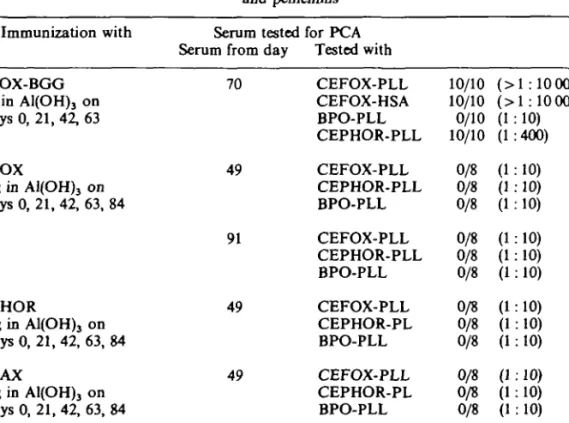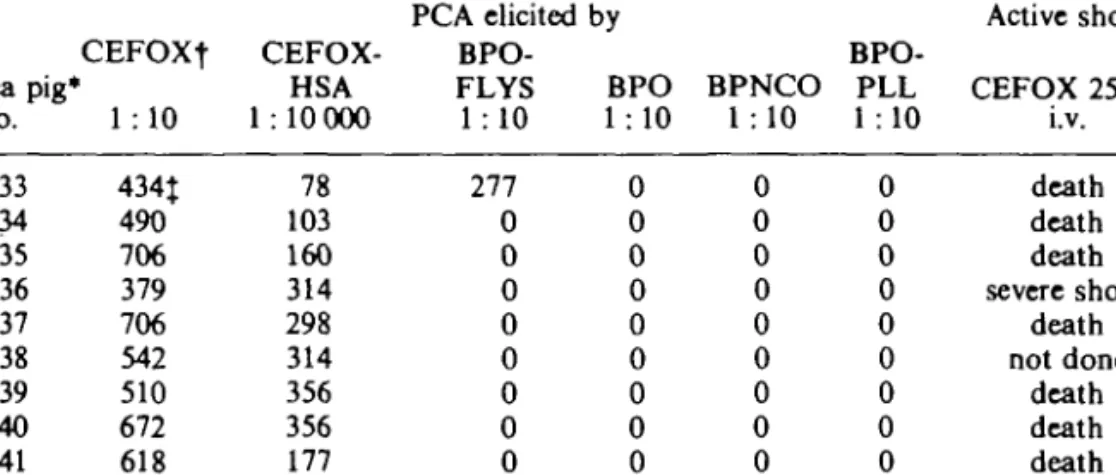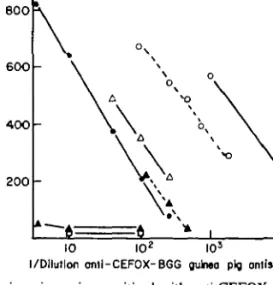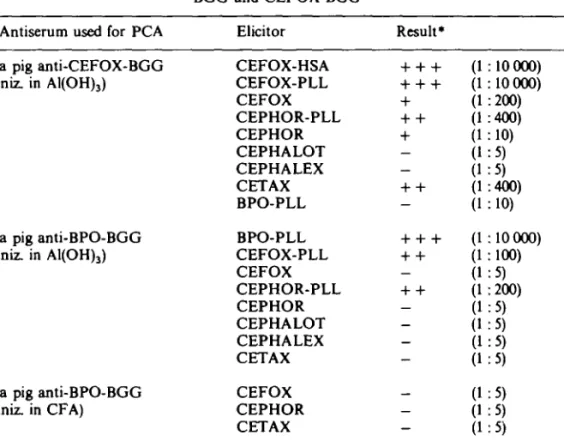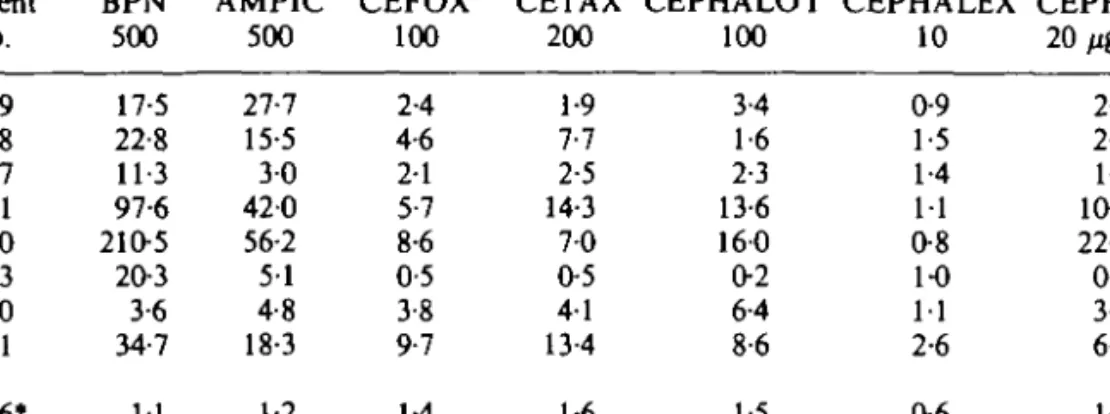Allergic and immunological aspects of therapy with cefotaxime and other
cephalosporins*
A. L. de Week and C H. Schneider Institute for Clinical Immunology, Inselspital
3010 Bern, Switzerland
Immunogenicity and allcrgcnicity studies in rodents show that cefotaxime and cefur-oxime are less immunogenic than benzylpenicillin or the semisynthetic penicillins. Cross-reactions of these antibiotics with benzylpenicilloyl-specific animal and human IgE antibodies appear minimal. Some cross-reactivity at the level of cell-mediated allergic reactions may, however, be expected.
Introduction
Allergic and immune reactions remain one of the major side-effects of /Wactam anti-biotics. However, as experience with natural and semisynthetic penicillins has shown, there may be variations in the incidence, the severity and also the clinical forms of allergic reactions to /Mactam antibiotics according to their structure, chemical reac-tivity, dosage and mode of administration. Therefore, the development of a new /J-lactam antibiotic raises the following questions: (1) Is this new antibiotic potentially
Cafuroxlmt N—OCHj Captalodn NH, CaphobrkJIna — 0 — C — N f — H Carotaxlrrw Ctphalothln • ^ — ^ — ff,: — 0 — C—i N—OCH,
OCH, * 0 1
-Flgort 1. Skie-chain structures and generic names of cephalosporins and some abbreviations.
•Abbreviations used: CEFOX, cefuroxime; CEPHALEX, cephalexin; CEPHOR, cephaloridine; CETAX, cefoUiime; CEPHALOT, cephalothin; BPO, benzylpenicilloyl; BPO-FLYS, N'-formyl-W-benzylpenidlloyl-L-lysine; BPNCO, benzylpenicilloic acid; BPN, benzylpenicillin; AMPIC, ampicillin; PLL, poly-N'-formyl-W-benzylpenidlloyl-L-lysine; BGG, bovine gamma globulin; HSA, human serum albumin.
161
162 A. L. de Week and C H. Schneider
sensitizing as the other drugs currently on the market? (2) Will this new penicillin or cephalosporin cross-react with other already established /Mactam antibiotics and cor-respondingly will it elicit allergic reactions in patients already hypersensitive to penicillin?
This brief presentation aims to answer these questions as far as cefotaxime (CETAX) and another cephalosporin of similar side-chain structure, cefuroxime (CEFOX) are concerned (Figure 1).
Immunogenicity
The capacity of /Mactam antibiotics to evoke immune responses and to sensitize has been classically linked, as for other sensitizing low-molecular weight chemicals, to their capacity to form covalent bonds with soluble and membrane proteins. Accordingly, chemical reactivity with various amino acids, peptides or proteins has sometimes been taken as a measure of the expected immune reactivity. Indeed, aminolysis rate among penicillins is variable and seems to correlate to some extent with the capacity to sensi-tize rodents. While the reactivity of penicillins to form the major penicilloyl antigenic determinant is well known, the corresponding immunochemistry of cephalosporins is more complex and has been less extensively studied (Dewdney, 1977). Studies on the chemical reactivity of cephalosporins with amines or proteins at various pH have sug-gested that cephalosporoyl amide, the equivalent of the penicilloyl haptenic group is of low stability and may decompose to more simple, e.g. penaldate, derivatives. Table L Comparative immunogenicity of CEFOX-BGG conjugate, CEFOX, CETAX, CEPHOR
and penicillins Immunization with CEFOX-BGG 1 fig in Al(OH)j on days 0, 21, 42, 63 CEFOX 1 mg in A1(OH)3 on days 0, 21, 42, 63, 84 CEPHOR 1 mg in A1(OH)3 on days 0, 21, 42, 63, 84 CETAX 1 mg in A1(OH)3 on days 0, 21, 42, 63, 84 Benzylpenicillin (BPN) Ampicillin (AMPI) Serum tested Serum from day
70 49 91 49 49 49 49 forPCA Tested with CEFOX-PLL CEFOX-HSA BPO-PLL CEPHOR-PLL CEFOX-PLL CEPHOR-PLL BPO-PLL CEFOX-PLL CEPHOR-PLL BPO-PLL CEFOX-PLL CEPHOR-PL BPO-PLL CEFOX-PLL CEPHOR-PL BPO-PLL BPO-PLL AMPI-PLL 10/10 10/10 0/10 10/10 0/8 0/8 0/8 0/8 0/8 0/8 0/8 0/8 0/8 0/8 0/8 0/8 17/20 3/8 ( > 1 : 1 0 000) ( > 1 : 1 0 000) (1:10) (1:400) 33 3 33 3 33 3 (1 :10) (1 :10) (1 :10) (1:200) (1:20)
Cephalosporin determinants having undergone such transformation retain the side-chain (Kj) but lack the dihydrothiazine ring (Hamilton-Miller, Newton & Abraham, 1970; Steinberger & Wiedermann, 1970).
Upon repeated injection of guinea pigs with penicillins either with various adjuvants or without adjuvant (thus mimicking therapeutic administration) large variations in the capacity to sensitize have been observed. While benzylpenicillin is regularly sensitiz-ing producsensitiz-ing antibodies of benzylpenicilloyl specificity, antibody production to, e.g. ampicillin, appears much less constant. We have been unable under experimental con-ditions to achieve sensitization either by cefotaxime or cefuroxime. However, when preformed protein conjugates are used for immunization high grade sensitization to the cephalosporins is regularly achieved with high titres of antibodies as detected by passive cutaneous anaphylaxis (Tables I and II). As studied in some detail in the penicillin Table n. Active and passive anaphylactic reactions in animals immunized with CEPHOX-BGG
Guinea no. CEFOXt Pig* 1:10 CEFOX-HSA 1:10000 PCA elicited BPO-FLYS 1:10 by BPO 1:10 BPNCO 1:10 BPO-PLL 1:10 Active shock CEFOX 25 mg l.V. 2133 2134 2135 2136 2137 2138 2139 2140 2141 2142 434J 490 706 379 706 542 510 672 618 370 78 103 160 314 298 314 356 356 177 490 111 0 0 0 0 0 0 0 0 0 0 0 0 0 0 0 0 0 0 0 0 0 0 0 0 0 0 0 0 0 0 0 0 0 0 0 0 0 0 0 death death death severe shock death not done death death death severe shock T e n guinea pigs immunized with 1 p.% CEFOX-BGG in A](OH)3; PCA with serum from day 105,
eli-citation of shock on day 109.
f EUcitor doses were 25 mg for monovalent compounds and 1 /jmol hapten for conjugates. The ratios given indicate serum dilutions.
{Blue reaction in mm2.
system, antibodies produced against the penicilloyl antigenic determinant may be di-vided into three categories: (a) those specific for the side-chain; (b) those specific for the thiazolidine nucleus; (c) those specific for the whole hapten. As will be discussed later, it appears that antibodies raised by cefuroxime-protein conjugates are to a large extent specific for the cefuroxime side-chain as very little cross-reactivity with other penicillins and/or cephalosporins could be demonstrated (Figure 2).
Can one predict the sensitizing capacity and the expected incidence of allergic re-actions in man from sensitizing experiments in guinea pigs or mice? There is, as yet, no definite answer to the question. It is striking, however, that the poorer antibody re-sponse to ampicillin in guinea pigs coincides with the fact that immediate-type reactions to ampicillins are also much rarer in man than those to benzylpenicillin. As far as the cephalosporins are concerned, the majority of studies performed thus far indicate that the incidence of allergic reactions is low despite a dosage which is often higher than used in penicillin therapy.
164 A. L. de Week and C H. Schneider
8 0 0
10
I/Dilution antl-CEFOX-BGG guln«a pig antlserum
Figure 2. Elicitation of PCA in guinea pigs sensitized with anti-CEFOX-BGG guinea pig antisemm by means of 01 ^unol CEFOX-HSA (O O); 01 junol CEFOX-PLL (O O); 25 mg CEFOX ( • • ) ; 25 mg CETAX (A A); 10 mg CEPHOR ( • A); Ol ^mol CEPHOR-PLL ( • A); 0-1 Fmol BPO-PLL (D D).
Allergenicity and cross-reactivity
The allergenicity, i.e. the capacity to elicit allergic reactions in already sensitized in-dividuals and the cross-reactivity of a new cephalosporin are obviously of interest in order to assess the risks of its potential use in a population which has been treated for many years by penicillins or other cephalosporins. It is generally estimated that 3 to 5 % of the individuals in industrialized countries are allergic to penicillins.
A first indication about the cross-reactivity and potential allergenicity of the new cephalosporins cefotaxime and cefuroxime may be gained from studying the cross-reactivity among antibodies raised in rodents by the corresponding cephalosporin- or penicilloyl-protein conjugates. In guinea pigs with very high titres of antibodies raised by cefuroxime-protein conjugates, there was practically no reaction with benzylpenicil-lin and benzylpenicilloyl-protein antigens (Table III). Even with other cephalosporins such as cephaloridine, cephalothin and cephalexin, only a very low grade of cross-reactivity was observed suggesting that the bulk of the antibodies raised by cefur-oxime-protein conjugates is directed against the side-chain and not against the entire cephalosporoyl moiety. The observation that cefotaxime is definitely cross-reacting with anti-bodies raised against cefuroxime would also fit into this picture since the respective
Rt side-chains of the two antibiotics share at least one structural element.
The antibody response obtained in guinea pigs against a cefotaxime-HSA conjugate has not yet reached full strength. Nevertheless it is obvious that at least a weak reaction in PCA with CEFOX-PLL is elicitable; on the other hand the lack of cross-reactivity with BPO-PLL is already apparent (Table IV).
The almost complete absence of cross-reactivity in human immediate-type allergy was confirmed by studies on the IgE penicilloyl-specific antibodies of patients allergic to penicillin. Among 22 individuals showing high levels of BPO-specific IgE antibodies demonstrated by the RAST test, no IgE antibodies against the cefuroxime group were detected (Table V). The same result is obtained from RAST inhibition experiments where BPO-specific RAST binding can virtually not be inhibited by cefotaxime or cefuroxime (Figure 3).
10 I0"4 10"
y inhibiting hopten
Figure 3. Inhibition of RAST (BPO-specific human IgE-binding to BPO-HSA-sepharose) by penicillin and cephalosporin haptens including CETAX (D • ) ; CEFOX ( • • ) ; BPN (O O); BPO-FLYS ( • • ) .
Table HI. Elicitation of PCA reactions by ccphalosporins with various antisera induced by BPO-BGG and CEFOX-BPO-BGG
Antiserum used for PCA Elicitor Result*
Guinea pig anti-CEFOX-BGG (immuniz. in A1(OH)3)
Guinea pig anti-BPO-BGG (immuniz. in A1(OH)3)
Guinea pig anti-BPO-BGG (immuniz. in CFA) Rabbit anti-BPO-BGG (immuniz. in CFA) CEFOX-HSA CEFOX-PLL CEFOX CEPHOR-PLL CEPHOR CEPHALOT CEPHALEX CETAX BPO-PLL BPO-PLL CEFOX-PLL CEFOX CEPHOR-PLL CEPHOR CEPHALOT CEPHALEX CETAX CEFOX CEPHOR CETAX CEFOX CEPHOR CETAX (1 (1 (1 (1 (1 (1 (1 (1 (1 (1 (1 (1 (1 (1 (1 (1 (1 (1 (1 (1 (1 (1 (1 : 10 000) : 10 000) :200) :400) :10) :5) :5) :400) :10) : 10000) :100) :5) :200) :5) :5) :5) :5) :5) :5) :5) :5) :5) :5) •In ( ), end point PCA titre or for negatives, lowest serum dilution tested.
166 A. L de Week and C H. Schneider
TaMe IV. Evaluation by PCA of CETAX-sensitized guinea pigs*
Elicitor Dose Fraction of animals affording positive sera at 1:10 1:100 1:1000 CETAX-PLL 01 /imol CEFOX-PLL 0-1 /imol BPO-PLL 01 /imol CETAX 1 mg CETAX 0-1 mg CEFOX 1 mg 8/8 1/8 0/8 2/8 1/8 2/8 6/8 ND 0/8 ND N D ND 4/8 ND 0/8 ND N D N D
•Eight guinea pigs immunized with 1 £ig CETAX-HSA in AJ(OH)3; PCA in guinea pigs with antisera from
day 90.
These results suggest that the penicillin- and cephalosporin-based haptenic structures do not share structural moieties of sufficient immunochemical importance to form a basis for IgE cross-reactivity. Indeed, reports of immediate-type reactions to cephalo-sporins in penicillin-allergic patients are rather rare (Scholand, Tennenbaum & Cerilli, 1968) and seem to involve mainly cephalosporins with the thiophene side-chain such as
Table V. Rast test with BPO and CEFOX in 22 patients allergic to penicillin
Penicillin-allergic patients: Normal sera: Buffer control; Patient serum no. 56 59 104 105 122 124 125 126 137 139 141 4 9 34 49 65 70 72 46 47 48 88 O P 2430 2024 2490 —
Labelled a-IgE (cts/min) bound to BPO-HSA-Sepharose 10 691 11882 6142 804 11890 32 651 4 298 2 528 16190 7 920 4 950 10 910 24 720 5 610 11875 7 256 13 910 9 225 29 017 20 788 25 311 39 610 460 328 372 398 619 CEFOX-HSA-Sepharose* 400 486 327 314 332 347 236 196 408 365 708 443 471 353 288 395 303 251 493 345 439 607 253 357 307 263 163
•Since we do not possess serum from a patient clinically sensitive to CEFOX as positive control, the suitability of the CEFOX-HSA-Sepharoic immunosorbent was checked from its ability to adsorb guinea pig anti-CEFOX antibodies.
cephalothin. Since the thiophene ring (Pressman & Grossberg, 1968) is immunochemi-cally and steriimmunochemi-cally very similar to the benzene side-chain of benzylpenicillin, and other closely related penicillins, the observed cross-reactions may be mainly due to side-chain similarity.
From our study on the specificity of antibodies raised in guinea pigs and man one would be tempted to predict that no cross-reactivity is to be expected between penicil-lins and cephalosporins provided the side-chains were sufficiently different in structure. This conclusion, however, has to be modified when considering the results of lym-phocyte culture experiments performed with lymlym-phocytes from penicillin-sensitized patients (Table VI). In that case, it is obvious that lymphocytes are stimulated to pro-liferate not only by penicillins but also by most of the cephalosporins. Indeed, both
Table VI. Lymphocyte reactivity (stimulation index) of patients allergic to penicillin Patient no. 1089 1098 1097 1101 1100 1103 1110 1111 1096* *Non-allergic BPN 500 17-5 22-8 113 97-6 210-5 20-3 3-6 34-7 11 patient. AMPIC 500 27-7 15-5 3 0 420 56-2 5 1 4-8 18-3 1-2 CEFOX 100 2-4 4-6 2 1 5-7 8-6 0-5 3-8 9-7 1-4 CETAX 200 1-9 7-7 2-5 14-3 7-0 0-5 4 1 13-4 1-6 CEPHALOT 100 3-4 1-6 2-3 13-6 160 0-2 6-4 8-6 1-5 CEPHALEX 10 0-9 1-5 1-4 11 0-8 1-0 11 2-6 0-6 CEPHOR 20 /ig/ml 2-3 2-1 1-2 10-4 22-4 0-8 3-6 6-8 1-0
cefotaxime and cefuroxime appeared to stimulate, although to a lesser extent, lym-phocytes from patients having undergone clinical allergic reactions to benzylpenicillin or to one of the semisynthetic penicillins. Accordingly, if immediate-type reactions in-volving antibodies, and especially IgE antibodies, will probably be very rare with cefo-taxime and cefuroxime in a population of penicillin-sensitized patients, cross-allergic manifestations based on cellular reactivity such as generalized maculo-papular exan-thema or fever may be expected in a sizeable proportion of cases.
In summary, cefotaxime and cefuroxime appear, at least under experimental con-ditions, to be less immunogenic than benzylpenicillin and semisynthetic penicillins and to be less prone to produce antibody of the IgE type. Cross-reactions with rodent or human IgE antibodies induced by benzylpenicillin appear to be minimal. Cross-reactions may be expected, however, between cephalosporins and penicillins carrying similar side-chains. Some cross-reactivity at the level of the nucleus on the other hand has been observed with penicillin-sensitized lymphocytes. Accordingly, some cross-reactivity at the level of cell-mediated allergic reactions may be expected. In comparison to some other cephalosporins, cefotaxime appears to be less toxic for the lymphoid cells and macrophages required for immune defences.
References
Dewdney, J. M. Immunology of the antibiotics. In The Antigens, Vol. IV (Sela, M., Ed.) Academic PTCSS, New York (1977), pp. 74-245.
168 A. L. de Week and C H. Schneider
Hamilton-Miller, J. M. T., Newton, G. G. F. & Abraham, E. P. Products of aminolysis and enzymic hydrolysis of the cephalosporins. Biochemical Journal 116: 371-84 (1970).
Pressman, D. & Grossberg, A. L. The Structural Basis of Antibody Specificity. Benjamin, New York (1968), pp. 50-2.
Stemberger, H. & Wiedermann, C. Untersuchungen uber die Bindung von Cephalosporin-C-Antibiotica an Eiweiss. Zeitschrift lmmunitatsforschung und experimentellt Therapie 140: 43-9 (1970).
Scholand, J. F., Tennenbaum, J. I. & Cerilli, G. J. Anaphylaxis to cephalothin in a patient allergic to penicillin. Journal of the American Medical Association 206: 130-3 (1968).
